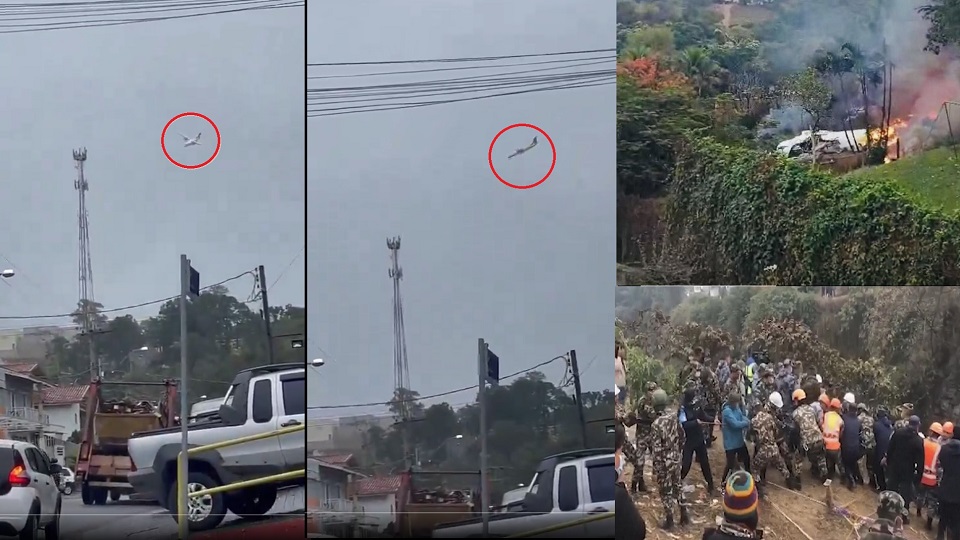Aviation
VoePass Plane crash in Brazil’s São Paulo state kills all 61 on board

Voepass Flight 2283, an ATR passenger aircraft, crashed in Vinhedo, Brazil.
A plane atr 72-500 turboprop carrying 62 people crashed in a residential area of Vinhedo, São Paulo state, Brazil, on Friday. The crash resulted in a massive fire, and it remains unclear how many people were injured or killed.
Witnesses described the aircraft as falling straight down, raising concerns about the cause of the incident.
How does the ATR-42 water crash land in comparison to the A320 and B737?
VoePass Airlines confirmed that the flight, which was bound for São Paulo’s Guarulhos International Airport, had 58 passengers and 4 crew members on board. The airline did not specify the cause of the crash.
A Fatal plane crash today, Firefighters confirmed that the plane went down in Vinhedo, but further details have not yet been released.
Click here : Graphic warning https://twitter.com/dom_lucre/status/1821978394441007432
Emergency teams are on the scene, and there are fears of fatalities among both those on the plane and people on the ground.
Brazilian television network GloboNews broadcast footage showing flat spin aircraft a large fire and smoke rising from what appeared to be the plane’s fuselage in a densely populated neighborhood.
This led in the crash of Yeti Airlines Flight 691, which killed 72 lives.
Additional footage depicted the aircraft spiraling downward before crashing.
During a public event in southern Brazil, President Luiz Inácio Lula da Silva led the crowd in a moment of silence for the victims.
The aircraft was on a flight from Cascavel to Guarulhos when it crashed, and initial reports suggest that 70 people may have lost their lives.
New video shows Voepass Flight 2283 crashing into houses in Vinhedo, but the exact number of casualties remains uncertain.

Aviation
COMAC Unveils Plans for the C929 to Rival Airbus and Boeing

After the success of China’s first C919 aircraft, the country is setting its sights on developing a larger plane. COMAC (Commercial Aircraft Corporation of China) has officially confirmed plans to build a widebody aircraft, marking a significant step in its aircraft lineup.
Traditionally, Airbus and Boeing dominate the widebody aircraft market, with decades of expertise in developing planes and engines capable of carrying heavy payloads. China, which currently relies on imported engines, is now aiming to challenge these giants with its own widebody jet, the C929, designed to compete with the Airbus A350 and Boeing 777.
American Airlines Is Looking for Flight Attendants: Apply Now
The C929 will be China’s first independently developed long-range widebody aircraft. It adheres to international airworthiness standards and boasts independent intellectual property rights. The baseline version is designed to seat 280 passengers and offers a range of 12,000 kilometers, catering to global demand for both regional and international air travel.
Russia, which also needs reliable narrowbody and widebody aircraft, could become a key customer for the C929. Additionally, China plans to target the broader Asian market as it continues to expand its aviation capabilities.
Close Call at Heathrow: BA Flight Narrowly Escapes Drone Collision
China’s aviation progress includes the ARJ21 (now called C909), a regional jet with 100 seats for shorter routes, and the C919, a narrowbody jet with 180 seats designed to rival the Boeing 737 MAX and Airbus A320. Both models have found increasing demand in the domestic market.
At China’s largest air show in Zhuhai, COMAC announced that Air China will be the launch customer for the C929 widebody jet, though details about order size and delivery timelines were not disclosed.
Other major deals announced by COMAC include:
- Hainan Airlines: Firm orders for 60 C919 and 40 C909 regional jets.
- Colorful Guizhou Airlines: 30 C909 jets, with 20 firm orders and 10 provisional agreements.
The C929, renamed from the CR929 after Russia withdrew from the joint development project in 2023, is expected to carry 280–400 passengers with a range of 12,000 kilometers, competing directly with Boeing’s 787 Dreamliner.
According to COMAC’s deputy general manager, Tong Yu, the first fuselage section of the C929 is expected by September 2027, with prototype test flights anticipated soon after.
-

 Aviation2 months ago
Aviation2 months agoMicrosoft Flight Simulator Raises $3 Million to Bring Back the An-225 Mriya
-

 Airlines2 months ago
Airlines2 months agoQantas Engineers Stage Walkout Over Cost of Living Concerns
-

 Airlines2 months ago
Airlines2 months agoQatar Citizens Can Travel to the United States Without a Visa
-

 Aviation2 months ago
Aviation2 months agoQatar Airways bans these new Electronic Devices on plane
-

 Airlines2 months ago
Airlines2 months agoJapan Airlines Rolls Out Free Domestic Flights to International Passengers
-

 Defence2 months ago
Defence2 months agoWhich Country Has the Largest Fleet of Fighter Aircraft?
-

 Airport2 months ago
Airport2 months agoWestern Sydney Airport Welcomes Its First Plane After 6 Years of construction
-

 Aviation2 months ago
Aviation2 months agoDid you know ? Once Boeing 747 carried 1088 passenger in 1991








